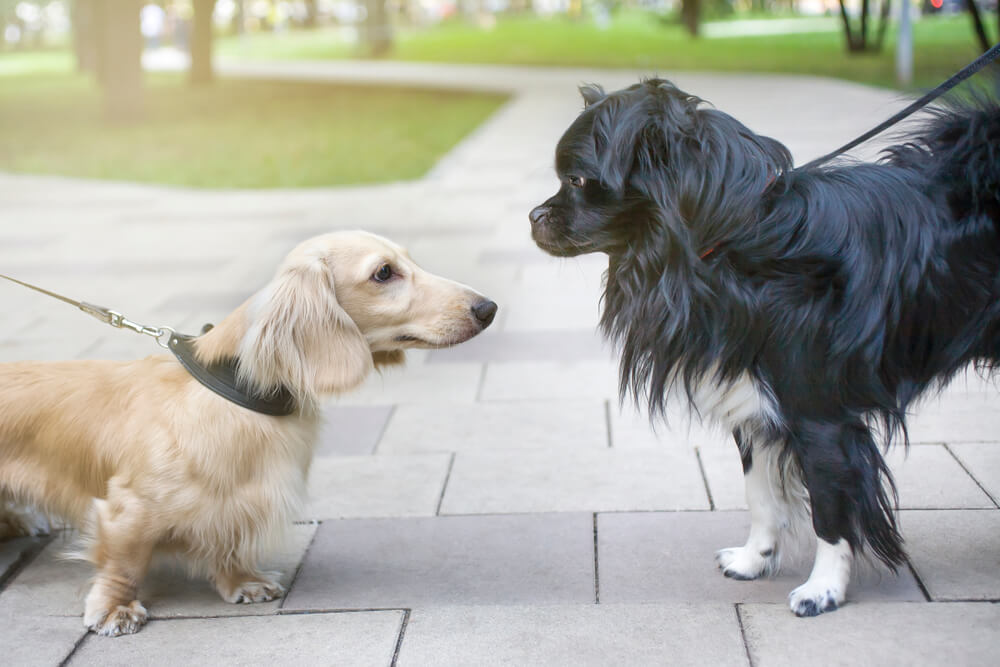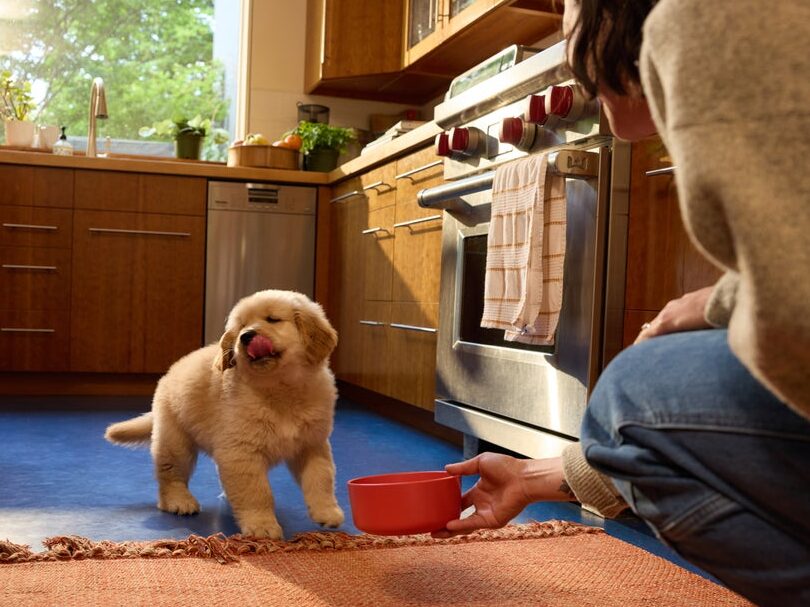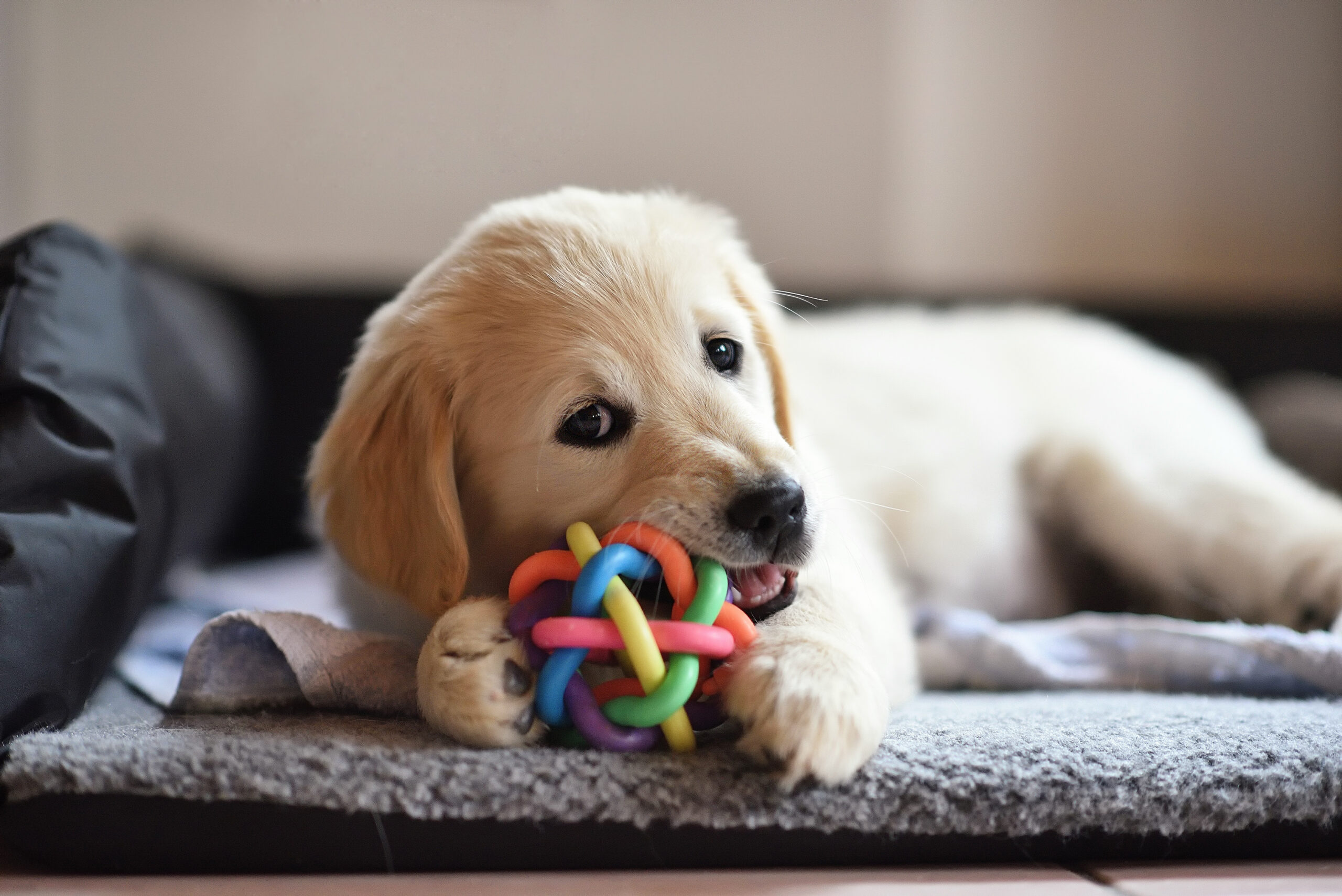Hey Ollie blog readers! We’re offering you an exclusive 60% OFF your starter box! Try now!
Introducing dogs to new dogs safely is critically important. This is especially important when bringing a new dog into your home. Whether the new dog is going to be a permanent “sibling”, or a temporary house guest or foster you want to set up everyone involved for success.
A lot of this advice centers around making sure both dogs are comfortable and learning to read your dog’s emotions and body language. Before you introduce your dog to another dog, make sure you can identify body language for happy, anxious, scared or angry dogs.
How To Introduce Dogs To Each Other
ntroducing dogs to each other takes patience and the right setting. The goal is to create a calm, positive first impression that helps both dogs feel safe. Start by choosing a neutral location, like a quiet park or open outdoor space. Avoid either dog’s home turf at first, since territorial instincts can trigger tension.
Keep both dogs on a leash, but leave enough slack so they don’t feel restricted. Walk them side by side at a comfortable distance, allowing them to get used to each other’s presence without direct contact. Watch their body language—loose tails, soft eyes, and relaxed postures are good signs. If either dog stiffens, growls, or pulls hard, take a break and create more space.
When they seem calm, let them sniff briefly and then redirect with a short walk. Keep greetings short at first and gradually allow more interaction as they relax. Don’t force it—some dogs warm up quickly, while others need more time. Always supervise their early time together and reward calm behavior with praise or a treat. Positive introductions build the foundation for a healthy relationship between dogs.
Six tips for introducing two dogs
1. First impressions matter
You want to set the scene when introducing two new dogs. Try to find a time when both dogs are well rested (so no intros right out of the car after a long trip) and not just before mealtime when the dogs are at their hungriest. You also might want to play with each dog first so they’ve had a bit of exercise first. This will help you make sure your dog is ready to mingle!
2. Meet on neutral territory
This will put the dogs on more even footing. Bringing a new dog into your home for a meeting might make your dog territorial or protective of you, his home, his toys or his food. This can cause your dog to bark, growl or act aggressively as he is protecting what is his. It is especially important to know if your dog is food or toy aggressive and ensure that if that is the case either food or toys are not present when you’re making introductions.
3. Meet on leash first
A good way to introduce new dogs is by taking them for a walk together. Both dogs should start on leash, under the control of their handlers a comfortable distance apart. Let them see each other as they walk, but don’t rush to let them interact or play. They will most likely be very curious about each other. You can gradually bring them closer together, eventually allowing them to interact. The whole time you want to make sure that you are keeping an eye on body language and that neither dog is showing signs of aggression, fear or anxiety.
4. Allow the dogs to smell each other
Dogs learn a lot about each other by sniffing. If the dogs are sniffing each other they are learning important information about the other dog. It is okay to let them sniff each other for a while. You can offer praise for this behavior as it is considered a polite (dog) greeting.
5. Go slowly and reward positive interaction
This tip is especially important when bringing a new dog into your home. “New dogs are stressed enough, give them time to adjust and settle in without being molested by the resident dogs. I separate them totally by baby gates and stuff and potty them separately at first. “ Says Katie Swales, DVM of Rainbow Vet in Darlington, PA. She also says watch the body language of each dog behind the baby gate, if the dogs are relaxed or just curious about each other she says the next step would be to walk the dogs together or let them meet in her backyard. Try not to do too much too fast, as you don’t want to overwhelm either dog. You can also offer each dog praise and treats for positive interaction.
6. Monitor dogs body language throughout the interaction
An older dog may try to establish dominance over a younger dog (or new puppy). The dog might growl or bark at the pup as a warning to “back off” this is important communication between the dogs and you should allow the older dog to communicate. That said, you want to make sure to keep the puppy safe. Puppies are still learning how to socialize and don’t always know all of the rules or other social cues yet. If behavior turns more aggressive then just a warning, you need to separate the dogs to give them a break.
The additional body language you want to look for is signs that a dog that is scared, nervous or tired. This might indicate that your dog (or the other dog) needs a break. If you see either dog moving away to rest, tucking their tail between their legs, raising the fur on the back of their necks or pinning their ears it is time for a break. This can be accomplished by allowing the dogs to rest in separate rooms. You can give them each a stuffed kong or something to chew on while they relax if that is something they enjoy.
If one of the dogs “bows” and wags its tail that is a good sign that the dog wants to play. This is a great sign (as long as the other dog in the pair is amenable). The dog who is interested in playing may also bark or wag its tail. If you do allow the dogs to play, continue to monitor to make sure both dogs are having fun and play doesn’t escalate into a fight!
Three factors which may influence how well dogs interact with each other
- Location of meeting
As mentioned, two dogs meeting for the first time in one of the dog’s homes, may not set you up for success as the dogs aren’t on even footing. The dog whose home you’re in may become territorial. Try introducing new dogs in a neutral place like on a walk or in a park. If you’re adopting or fostering a dog, the shelter or rescue might require you to bring your dog for a meet first to ensure a good fit. They’ll likely have a special place to do this.
- Age of dogs
Some older dogs LOVE puppies while others can’t stand the running and nibbles and playing. Know the personalities of the dogs that you’re introducing and if your senior dog hates puppies, it may not be necessary for them to interact with young pups. It could be easier to introduce puppies to each other, like in puppy socialization or ‘kindergarten’ classes. The instructor will give directions before allowing the puppies to interact with each other. You’ll still need to monitor the dog’s play as you don’t want them to get too rough or the shy dogs to be intimidated. Regardless of age, some dogs prefer to socialize more than others. This should be taken into consideration.
- Personalities
Some dogs are outgoing and high energy, they love to meet anyone and everyone, both human and canine. Other dogs are shy or more reserved, they prefer to hang with the humans or rest quietly. Mixing these two personalities can be a challenge. It will be easier to introduce dogs with similar temperaments, interests and play styles.
Just like meeting new people, the first time two dogs meet it might not go perfectly. The most important thing is keeping everyone involved safe and comfortable. If your dog is showing signs of fear or stress when meeting a new dog (or person) it is best to end the interaction and allow your dog to calm down. You can always try again another day, or enlist the help of a qualified trainer to help make the introduction as successful as it can be.
The Ollie blog is devoted to helping pet parents lead healthier lives with their pups. If you want to learn more about our fresh, human-grade food, check out MyOllie.com.
Tagged As:

The nutrition your dog needs,
the food they want.

Enjoying our articles? Subscribe our Newsletters and get new articles directly to your inbox
You might also like
13 May 2025
8 MINS READ
Puppy Training Guide & Behavior Timeline
Bringing home a puppy is pure magic. It’s also pure chaos—tiny teeth, zoomies, accidents in the house, and moments that make you wonder if you’re raising a future genius or a tiny tornado. …
by Ollie Pets
10 May 2025
12 MINS READ
New Puppy Checklist: Guide To Prepare For A New Dog
Bringing home a new puppy? This checklist covers everything new dog owners need—from essential supplies to training, feeding, and first vet visits.
by Ollie Pets
3 April 2025
9 MINS READ
Home Remedies for Fleas on Dogs: 10 Natural Ways That Actually Work
Wondering what kills fleas on dogs instantly and naturally? If your pup is scratching like crazy, it may be time to take action. In this guide, we’ll show you the most effective home remedies for…







